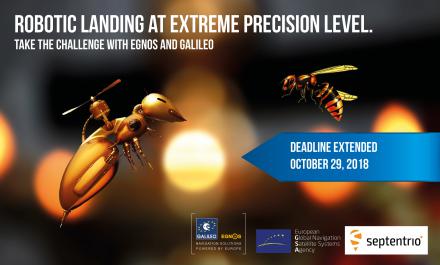The European GNSS Agency (GSA) is partnering with GNSS receiver manufacturer Septentrio to award a prize in the ERL Emergency Local Tournament 2019, which aims to foster advanced developments of autonomous capabilities and seamless navigation for emergency robotic systems.
The European Robotics League (ERL) is an  innovative robot competition that stems from its predecessors - the euRathlon and RoCKIn competitions - and focuses on tasks that robots must execute in realistic emergency situations. The competition is composed of multiple local tournaments, held in different locations across Europe, in addition to a few major events.
innovative robot competition that stems from its predecessors - the euRathlon and RoCKIn competitions - and focuses on tasks that robots must execute in realistic emergency situations. The competition is composed of multiple local tournaments, held in different locations across Europe, in addition to a few major events.
The first of the ERL Emergency challenges was announced in July 2018, and focused on land and sea robotic systems. The second, the deadline for which has been extended until 29 October, will be held in February 2019 at the premises of the Advanced Centre for Aerospace Technologies (CATEC) in Seville, Spain. This time the challenge will include air and land robots working in an outdoor/indoor environment. You can find more information about the challenges here.
Read this: Integrating GNSS in UAVs for faster SAR
Teams participate in a minimum of two tournaments (local and/or major) per year and get scores based on their performances. Each team’s top two tournament scores are then added together and the teams are ranked based on their cumulative score. Prizes for the top teams are awarded at the following year’s European Robotics Forum (ERF).
GSA-Septentrio Prize
The GSA will award a special prize at ERL Emergency 2019 focusing on robots that make use of solutions based on Galileo and EGNOS. This year, the Agency is partnering with the receiver manufacturer Septentrio, which will offer an AsteRx-i S receiver to the winning team.
Septentrio designs and manufactures highly accurate GNSS receivers for demanding applications requiring accuracies in the decimetre or centimetre range, even under difficult conditions. With its size, weight and power consumption, the AsteRx-i S is ideal for applications such as inspection with UAV's, UAS photogrammetry, automation, robotics and logistics.
“Whether it’s on the high seas, in scintillation prone areas or at high latitudes, our customers know that Septentrio receivers deliver fast, accurate and reliable positions. Our clients are active in urban canyons, under canopies or even under circumstances where there is deliberate interference, we make robust receivers to help our customers excel. It’s our long term vision to enable our customers’ success with GNSS,” said Septentrio Global Marketing Communications Manager Bas Broothaerts.
The challenge
The challenge this year is different depending on whether the teams work with air or land robots. For air robots, this challenge will involve two types of tasks: horizontal accuracy in landings at a specific geographic coordinate; and vertical accuracy while hovering at a specific geographic coordinate. For land robots, there will be only one type of task - horizontal accuracy during waypoint-based navigation.
Visual markers will be used to support the assessment of both types of task. To be eligible for the award, a team must have executed valid trials of the tasks. The team deemed to have achieved the best results will be declared the winner. For information on Galileo capable receivers and navigation kits for robotic systems visit https://www.usegalileo.eu/EN/.
Last chance to register!
If you are interested in participating in this ERL Emergency Local Tournament, you should register your team here by the deadline of October 29. For more information, click here.
Media note: This feature can be republished without charge provided the European GNSS Agency (GSA) is acknowledged as the source at the top or the bottom of the story. You must request permission before you use any of the photographs on the site. If you republish, we would be grateful if you could link back to the GSA website (http://www.gsa.europa.eu).